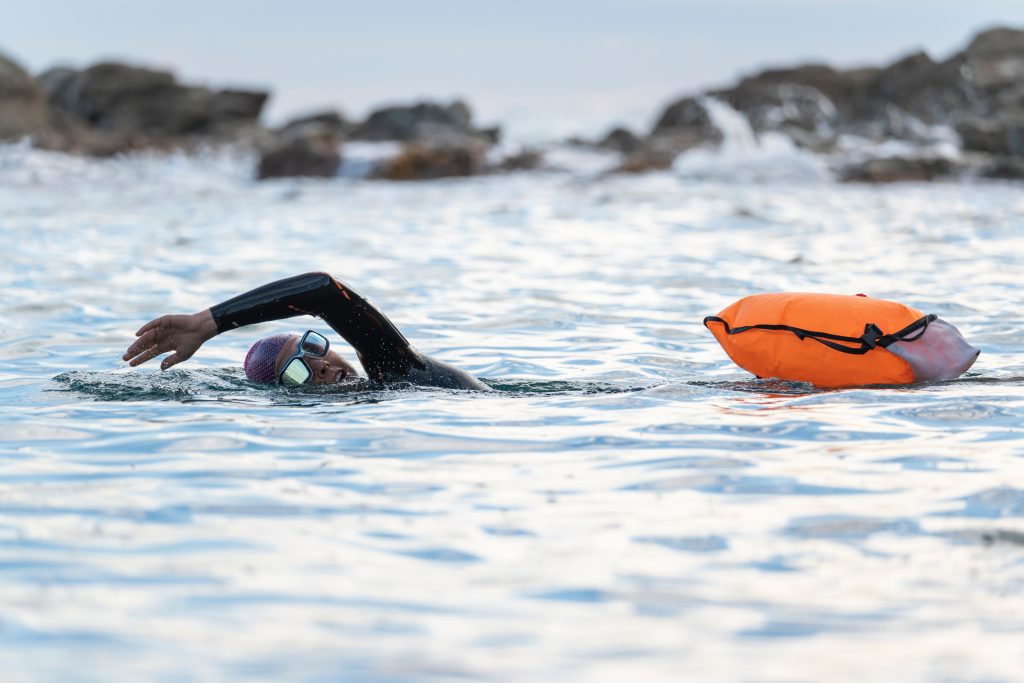OPEN WATER SWIMMING

YOUR GUIDE TO ENJOYING IT SAFELY
Open-water swimming has both physical and mental health benefits for all of us. Many people describe the feeling of intense satisfaction after plunging into cold water. It leaves the body tingling all over and helps clear the mind of worries and anxieties.
Year-round swimmers are adamant that the sea has the potential to alleviate the effects of a number of physical ailments, including arthritis and chronic pain, among others. But before you dive in, here’s the know-how you need to stay safe.
CHECK THE WEATHER FORECAST AND TIDES
Always check the wind and weather forecasts before swimming, and then check the type of tides. Spring tides are more hazardous as they cause stronger rip currents on beaches and increase the risk of stranding. Use local knowledge to identify the location of the rip currents on your beach or bathing area. It is much safer to swim on a rising tide than on a falling tide. Use an app on your phone, websites online, or newspapers for further real-time information about tides (e.g., Tides Near Me).
WHEN TO SWIM IN OPEN WATER
Start in the summer when the water temperature in Ireland is somewhere between 14° and 18° Celsius. The sensible way to acclimatize to cold water is to swim in it regularly. Then gradually extend your time in the water with practice. For the beginner or novice swimmer, our advice is “Swim within your depth – stay within your depth.” When entering the water, throw some water down the back of your neck to help prepare your body for the cold water immersion; this helps reduce the risk of cold water shock.
WATER TEMPERATURES AND BUOYANCY
Sea water can vary from 5° Celsius in the winter to 25° Celsius in a heatwave. Freshwater can vary from as low as 1° Celsius in the winter to 27° Celsius in a heatwave. The salinity of saltwater gives you approximately 14% extra buoyancy in the water, making it easier to swim there than in fresh water.
SWIMMER OR DIPPER? PUT SAFETY FIRST
Make these rules your mantra whenever you get in the water. If you don’t, you’re putting your life and the lives of others who may try to rescue you at risk.
- NEVER SWIM ALONE
Our climate is unpredictable, which means the sea can change very quickly. Heed the advice given by regular swimmers. If they are not getting into the water due to conditions, then do not enter the water. If you do get into difficulty, remain calm, try to float or tread water until you can either continue swimming or are rescued.
- MAKE SURE YOU CAN BE SEEN
It is essential that you wear a brightly coloured swimming cap—yellow, pink, or a colour that stands out in the water—so that other water users can see you. You should also use a bright-coloured tow float for the same reason. Don’t be naive about your vulnerability in the water. Boats and jet skis, depending on their speed, can pose a real threat to you, similar to a vehicle on the open road.
- ALCOHOL AND WATER NEVER MIX
Three in ten people who drown have consumed alcohol before entering the water. Alcohol severely reduces your ability to swim and respond to risks as it impairs your judgment. Do not consume alcohol before you enter open water, and just as with driving, do not swim in open water the day after drinking alcohol.
- LISTEN TO YOUR BODY
Do not let yourself get too cold in the water. Your body will react differently to the cold on different days. If you are tired or developing a cold or flu, you can start to feel colder faster than usual. Always tailor the length of your swim to how you are feeling on a given day. Get out if you are not feeling comfortable, and never set time goals for staying in the water.
- WARM UP FAST
After your swim, it is important to warm up as quickly as possible. Once you get out of the water, you can continue to cool for approximately 20-30 minutes. This means that your deep body or core temperature will be cooler 20-30 minutes after your swim than when you got out of the water. Get dry and dressed in warm layers of clothing as quickly as possible. Warm drinks are also a great way to bring your body temperature back to normal. Bring a flask of your favourite hot drink with you.
CHECKLIST TO BRING WHEN OPEN WATER SWIMMING
- A silicone cap if swimming all year round, with an additional neoprene cap for winter months.
- A dry absorbent towel.
- Ear plugs, especially from October to May.
- A tow float, even when swimming close to shore, and especially at slipways and piers.
- A standing mat, particularly from October to May, to counteract the severity of the cold ground while changing in and out.
- Floating goggles and a bottle of baby shampoo to rinse them off after each swim, preventing fogging and increasing visibility.
- A thermal flask containing a hot drink to consume after exiting the water.
- A thermal beanie cap to wear immediately upon exiting the water, along with warm clothing.
- Booties or socks.
- Gloves.
GUIDELINES AND ADVICE
A useful rule of thumb for beginner and novice open water swimmers is “Get in warm – get out warm.” More experienced open water swimmers should always remember 2 minutes per water degree Celsius. So if the water is 14°C, the maximum time in the water is 28 minutes; at 6°C, the maximum time is 12 minutes, and only if you are feeling well. During the winter months, we recommend wearing a neoprene cap, gloves, booties or socks, and using floating goggles.
SWIMMING AT NIGHT
The dangers of swimming at night far outweigh the benefits. Swimming at night substantially impairs your visibility, as well as your ability to see and appreciate hazards. Night swims should only be undertaken by experienced open-water swimmers. Lightsticks and tow floats should be used, and there must be surface rescue with lifeguards, kayaks, and safety boats appropriate for the number of swimmers in the water.
OTHER DANGERS TO BE AWARE OF
At low water, you are more likely to be stung by a Weever fish sting when entering or leaving the water from beaches, especially on spring tides. In fresh and saltwater, you are also more likely to slip or fall on surfaces with algae on them. During high water in the summer, be aware of jellyfish infestations at your swimming location. Lion’s Mane jellyfish and the Portuguese Man of War are potentially dangerous and can inflict severe stings.
FOR LOTS MORE INFORMATION, VISIT: www.WATERSAFETY.IE/OPEN-WATER-SWIMMING

